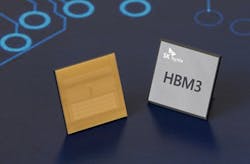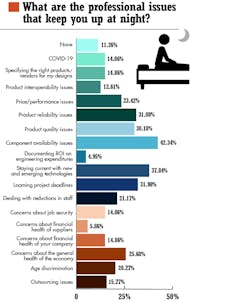Embedded Forecast: Better Hardware, Suspect Software
This article is part of the 2022 Electronic Design Forecast issue
What you'll learn:
- The influence of PCI Express, both with PCIe Gen 4 and the emergence of PCIe Gen 5.
- HBM and its support for ray tracing.
- Why RISC-V and small FPGAs will become more pervasive.
- The plight of open-source software.
For me, some articles seem to write themselves. Forecast articles don’t fall into this category probably because I see the consolidation and dependencies occurring within our industry that have made system design more complex. I can remember when size, weight, and power (SWaP) plus price were the main concerns for developers. These days, it also includes details like security, artificial intelligence, availability, communications, compatibility, and so on.
The challenge we have is the span of technology we cover from microcontrollers to cloud servers. The differences along the way have never been more stark. Integration of many different components into a single chip are more common at the low end while disaggregation is becoming the norm in the cloud. In the latter, storage and communication are being broken out from the server box into their own farms connected via high-speed networks.
The growth of PCI Express (PCIe) 5 and the emerging PCIe 6 standard support the CXL and CCIX standards that allow direct access to peripherals and storage. CXL appears to have the momentum after absorbing Gen-Z.
PCIe Gen 4 will remain the mainstay this year, but PCIe Gen 5 platforms are the cutting edge. The challenge will be availability rather than technology. This is more of a concern for high-end applications as many embedded applications fare well even with PCIe Gen 3’s 4 Gtransfers/s/pin versus the 64-GT/s/pin rate for PCIe Gen 6.
We see similar support on the external memory space with the flavors of DDR4 remaining the technology of choice even as DDR5 raises its head this year. Price and availability will limit DDR5’s adoption, especially in the embedded space. DDR6 remains on the drawing board.
High bandwidth memory (HBM) also is becoming the norm, taking advantage of stacked memory dies that provide a higher capacity of on-chip memory and higher throughput. That’s due to the wide memory bus, which can’t be replicated with off-chip memory like DDR or GDDR DIMMs. HBM3 is the latest generation. HBM storage started on GPUs, but it’s used on CPUs and accelerators (Fig. 1).
Graphics processing can take advantage of HBM, and more support for ray tracing is leading to a higher demand for on-chip memory as well as offering a significantly improved graphical presentation. NVIDIA has been pushing ray tracing—the company has moved this support down from its top-end solution to the midrange, while Imagination Technologies has delivered support for mobile applications.
Ray tracing is useful but not limited to just gaming applications and multimedia creation. For instance, it will prove effective in virtual-reality (VR) applications. VR and augmented reality (AR) also are moving into the mainstream due to improved hardware.
The metaverse is more than hype, but it will be a while before the general public uses it en masse. This has as much to do with software as hardware. In the meantime, industrial applications of AR/VR will be where the money is, especially when tied into digital-twin support, which is growing significantly in the industry (Fig. 2). The reason for this success has less to do with lower costs but rather improvements of the software and the fact that training and support costs can be dramatically reduced using this technology.
But Back to Computers and CPUs
Though incremental improvements in single cores marches on, the payback in x86 and Arm platforms remains multicore solutions. Mixing different performance cores in an SoC has already been common but will become more prevalent. Likewise, security processors will be more prevalent and easier to utilize especially when moving to deployment. Security has finally moved from a possibility to a requirement when connecting to the cloud.
The growing elephant in the room is RISC-V. Yes, it’s just an instruction set definition, but it essentially provides an architecture to build hardware and there are lots of sources these days. Standard, standalone chips are available as well as RISC-V integrated FPGAs and so on. Outfits like Imagination Technologies have added RISC-V to their portfolio. This isn’t to say the x86 or Arm architectures are going away, but they now have a significant and distributed competitor.
Another item to look out for is small FPGAs. Though they have been around for a long time, the focus often seems to be on higher-end, higher-performance solutions. What small-count logic devices can do is provide hardware customization that offers a power and price performance edge versus software alternatives. Development tools are easier to use, so all you need is a logic diagram. Given the limited availability of chips in general due to implications of the COVID-19 epidemic (Fig. 3), it makes sense to use a collection of more readily available FPGAs that can be customized.
Open-Source Software Challenges
Plenty of proprietary software and libraries are available, but the trend has been toward using open-source software for everything from operating systems to applications. Flavors of Microsoft Windows run on most PCs. However, versions of Linux, such as Android, run on most embedded systems.
Linux is one of many open-source success stories, but it also has significant industry support. That’s not the case for the majority of open-source projects. Of course, most open-source projects aren’t used by a large audience.
On the flip side, a wide audience of developers not supported by industry still utilize many of these projects. It’s led to some challenges for developers that use the fruits of these projects when problem occur. These can range from poor design or usage that open up security holes like Apache Log4j or bugs such as OpenSSL’s Heartbleed.
Software inventory and composition software is already a critical tool for some developers that need to track and verify their open-source use. The use of these software composition analysis (SCA) tools will be important for any developers utilizing open-source libraries and tools. It will also increase the interest in companies providing open-source software that they support, thereby alleviating the customer of this chore. Things become a bit more challenging when the end product must be certified.
Read more articles in the 2022 Electronic Design Forecast issue
About the Author
William G. Wong
Senior Content Director - Electronic Design and Microwaves & RF
I am Editor of Electronic Design focusing on embedded, software, and systems. As Senior Content Director, I also manage Microwaves & RF and I work with a great team of editors to provide engineers, programmers, developers and technical managers with interesting and useful articles and videos on a regular basis. Check out our free newsletters to see the latest content.
You can send press releases for new products for possible coverage on the website. I am also interested in receiving contributed articles for publishing on our website. Use our template and send to me along with a signed release form.
Check out my blog, AltEmbedded on Electronic Design, as well as his latest articles on this site that are listed below.
You can visit my social media via these links:
- AltEmbedded on Electronic Design
- Bill Wong on Facebook
- @AltEmbedded on Twitter
- Bill Wong on LinkedIn
I earned a Bachelor of Electrical Engineering at the Georgia Institute of Technology and a Masters in Computer Science from Rutgers University. I still do a bit of programming using everything from C and C++ to Rust and Ada/SPARK. I do a bit of PHP programming for Drupal websites. I have posted a few Drupal modules.
I still get a hand on software and electronic hardware. Some of this can be found on our Kit Close-Up video series. You can also see me on many of our TechXchange Talk videos. I am interested in a range of projects from robotics to artificial intelligence.




